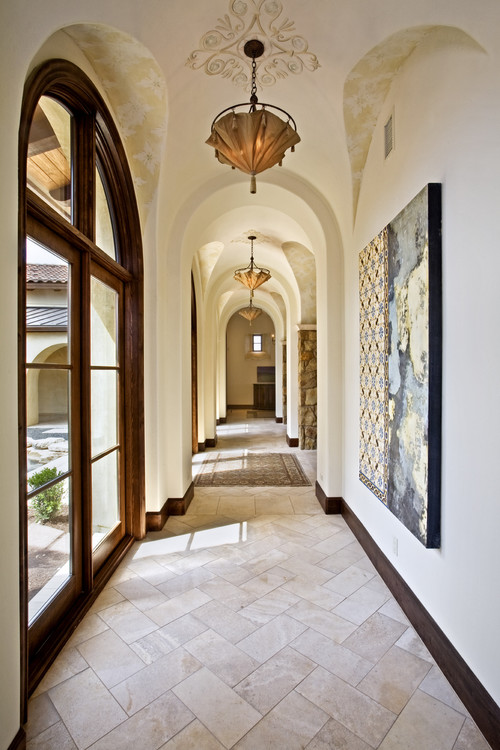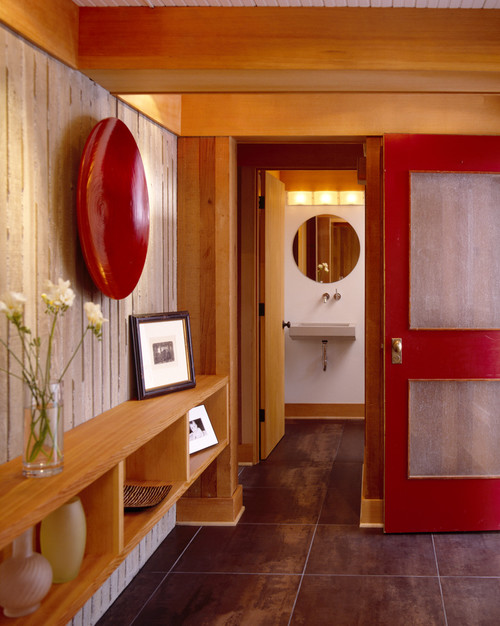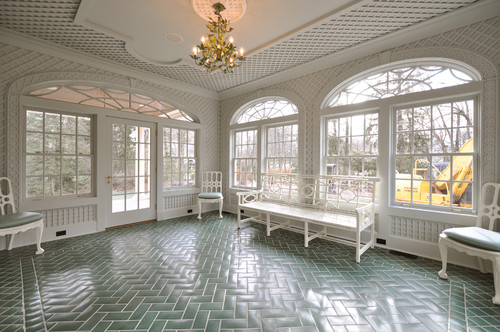Design Dilemma: A Guide to Floor Tile Patterns
When it comes to laying tile, there are a myriad of patterns to choose from. And each different pattern can lend a dramatically different feeling to your space. Some patterns seem to make a space contract, while others expand it. Some patterns work better in narrow spaces, and others in large ones. Some patterns feel very modern, while others feel Old World. Here’s what you should know about selecting a tile pattern for the best effect in your space.
Straight lay tile pattern.
This is probably the most common floor tile pattern. Tiles are laid in a simple grid pattern with corners matched up and grout applied in straight intersecting lines. The effect, as you can see above, is a clean, modern look. WHEN TO USE IT: This tile pattern works well in any room with a lot going on in terms of colors or patterns. That’s because the simple straight pattern provides no distractions. What’s more, the straight lines can be used to direct the eye into another space or a highlight in room. In the entry way above, the grid pattern reflects a modern zen feeling that is reflected in the use of natural wood trim. The lines of the tile lead straight to the accent wall featuring a red sculpture and tree pattern wall paper.
The Diagonal Tile Pattern
In this pattern, the simple grid pattern of the straight lay is tilted 45 degrees to achieve a diamond effect. WHEN TO USE IT: This is a great pattern to use when you want a room to look bigger and wider than it actually is. The diagonal pattern can accomplish this because the angle of the tile directs the eyes out to the corners of the room, making the room feel wider.
The Running Bond Tile Pattern
If you’ve ever seen a brick wall, you’ve seen the running bond. This pattern is the most common with rectangular tiles (for instance, subway tiles) and you’ll see it used on walls, backsplashes, bathroom tiles, patios and walkways. Each tile is lined up with the center of the tiles directly above and below, creating a staggered pattern, yet a cohesive look. WHEN TO USE IT: Do you have an uneven surface or crooked walls? This pattern is the way to go, because it is the best for hiding imperfections. The staggered patterns tricks the eye, removing the focus off of individual tiles and onto the floor as a whole, making it nearly impossible to spot flaws.
The Herringbone Tile Pattern
This tile pattern gets its name from its resemblance to the skeleton of the Herring, a bony fish. In this pattern, the tiles are lined up at a 45 degree angle so that they are all parallel. This is repeated in reverse on the other side of the tiles, like a mirror image, creating a V shape. This pattern is common in Europe, where it provides a sense of elegance to any space. WHEN TO USE IT: The herringbone pattern works wonderfully in small rooms because it will make the space seem bigger. The V shape tricks the eye into following the sides of the room, similar to the effect in the diagonal tile pattern. Be careful of using this pattern in a large room, like the one above, or it can possibly look very busy. This pattern looks great in hallways, bathrooms and in kitchens with islands.
The Versailles French Modular Tile Pattern
This pattern uses a combination of 4 different tile sizes: 8″x8”, 8″x16”, 16″x16”, and 16″x24”. Elegant and graceful, yet also timeless, this pattern creates a feeling of randomness but without the chaos since the tiles repeat in a puzzle-like pattern that is perfectly balanced. Versailles is most often used with stone tiles like Travertine. WHEN TO USE IT: This pattern works especially well in kitchens or on patios and terraces.
A few tips on using tile patterns:
- Larger tiles make a small room appear bigger.
- Very small tiles can also make a small room appear bigger.
- Avoid the straight lay in a narrow room since the grout lines will echo and reinforce the lines of the walls.
- Keep it simple. Use three different materials or less for best effect.






Leave a Comment